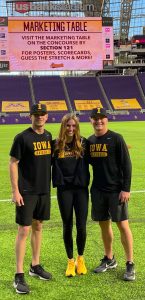*Guest post by remote intern, Bailey Raso
Starting at a young age, I always loved helping others. From helping my dad pull weeds in the yard, to offering to stay inside for recess to clean up the classroom or organize bookshelves for my elementary school teachers, I spent my days jumping in and helping others whenever possible. When I started swimming, I began to learn the true complexity of success and what helping others really meant. There was also opportunity to celebrate my own personal success, enjoying team successes, and feeling happy for others’ successes. My personal career in sports ended in high school, but I knew I found energy in a team and athletic atmosphere and was drawn to find ways to remain connected to it.
Iowa Baseball Program Experience
I grew up watching my older brother play baseball from t-ball through the collegiate level, but I never looked at baseball from an analytical perspective until the fall of my sophomore year in college, when I applied to be a Student Baseball Manager for the Iowa Baseball Program.
 I started as an Administrative Assistant for the program, but was eager to take every opportunity to learn, so I began to explore the other departments of our manager program as well. I expressed my sincere interest in learning more to better understand player development and, more specifically pitching development, to my fellow managers and the coaching staff and the immediate response was to help me find growth and learning opportunities in my expanding areas of interest.
I started as an Administrative Assistant for the program, but was eager to take every opportunity to learn, so I began to explore the other departments of our manager program as well. I expressed my sincere interest in learning more to better understand player development and, more specifically pitching development, to my fellow managers and the coaching staff and the immediate response was to help me find growth and learning opportunities in my expanding areas of interest.
I began to work as a Video & Scouting Manager during practice, helping to run the technology that captures and analyzes our player’s performance. This is when I discovered a passion for understanding biomechanics and motor learning.
In this space, I am extremely humbled and fortunate to have the opportunity to work with and learn from Iowa’s pitching coach, Coach Robin Lund. In the fall of 2020, Coach Lund wanted to take a deeper dive into incorporating more biomechanical analysis of our pitching staff. We captured video of our pitchers throwing fastballs off the mound from three different angles: a front-facing view, a back-facing view, and a view from behind the mound.
From there we analyzed each player’s video to see where they could implement biomechanical changes to improve performance, and created individualized motor learning plans for the remainder of the fall season.
As the months progressed and the pitchers were practicing drills that would help increase their mobility, stability, and momentum, I observed the positive progression in both movementquality and velocity of our players. I saw the direct impact that these changes had on the performance and success of each athlete and believe that these coaching programs are beneficial to helping an athlete in the baseball or softball realm reach their goals.
Researching. Observing. Expanding.
After researching, observing, and expanding my experience, I began to see consistencies in movement among numerous athletes. I believe that it is most valuable to assess each athlete based on their own natural movement and to help them move as efficiently as possible based on that, and not try to create cookie cutter pitchers and throwers.
From my perspective, a cookie cutter method could have the potential to create problems and risk of injury in individual athletes. Learning from Coach Lund, I really started to analyze athletes from the ground up, focusing on the placement and movement of their lower half before assessing their counter-rotation and arm path.
Internship with Wasserman Strength & High Level Throwing®
This summer, I have the incredible opportunity to intern with Wasserman Strength and High Level Throwing® to gain knowledge from Austin Wasserman on his philosophies and programs!
Being able to see how motor learning and conditioning programs have benefitted athletes younger than the collegiate level has also helped to confirm my observations and learnings. I have had the opportunity to assess both softball and baseball athletes, from pitchers to position players, and have been able to see how important association of lower half movement is to a young athlete.
The biggest consistency that I saw among all pitchers and throwers, was those who had a higher amount of core and hip stability were more efficient with the entirety of their motion. I believe that core and hip stability is a key focal point when supporting an athlete’s overall biomechanical efficiency.
Biomechanical Observations
There are a number of biomechanical observations I have been able to analyze through my internship with Wasserman Strength and High Level Throwing® when watching video of an athlete with weak hip and core stability or mobility. It can affect their overall balance, causing them to tilt forward or backward too much to maintain posture during a throw. Weak core and hip stability can also cause athletes to fly open with their upper half, or it can create an early extension of the hips that lifts their top half up.
It is beneficial to have efficient hip shoulder separation, but with a limited amount of mobility or stability in the lower half, it can cause movement to be out of sync and can impact the disconnection in this shift. This can limit the amount that a pitcher or position player can fully rotate with their whole body when throwing, which can cause an over-rotation of the top half of the body, or an inefficient arm path to try to compensate for velocity lost in the lower half.
If an athlete is habitual in inefficient movement and has weak core and hip stability and mobility, it can have the potential to increase injury in certain areas of the body, such as their shoulder and elbow. It is important to teach athletes drills that will help strengthen their legs and core as well as increase flexibility and mobility, so that they can get the most out of their movement. So much momentum and stabilization comes from the lower half of the body when in a pitching or throwing motion, and I believe that it is essential to help athletes understand how to develop these areas to optimize performance.
Create Opportunity
With the knowledge that I am continuing to gain through Wasserman Strength, High Level Throwing® and the Iowa Baseball Program on how to analyze athletes, I have a deeper understanding and passion for supporting, jumping in, and increasing the confidence in a player’s performance success long-term.
I have seen athletes that participate in Wasserman’s trainings and clinics improve their strength, efficiency, and overall performance while reducing susceptibility to injury. I’ve always felt that my passion was to help others achieve success. To be able to align that with my love for sports and an active lifestyle has been a dream come true.
I am very grateful for the many opportunities that I’ve been afforded, and to learn from tremendous mentors and experts in the industry. I look forward to continuing to grow both professionally and personally and make a positive impact in athlete’s lives!
 Bailey Raso is from Iowa City and is going into her senior year at the University of Iowa. She is majoring in Health and Human Physiology and minoring in Sports and Recreation Management. She is a Student Manager for the Iowa Baseball Team and aspires to become a pitching coach at the collegiate level post-graduation.
Bailey Raso is from Iowa City and is going into her senior year at the University of Iowa. She is majoring in Health and Human Physiology and minoring in Sports and Recreation Management. She is a Student Manager for the Iowa Baseball Team and aspires to become a pitching coach at the collegiate level post-graduation.
Bailey is looking forward to working with the online softball athletes this summer as a remote softball performance coach and High Level Throwing® Intern. She is excited to learn from the coaches and staff at Wasserman Strength and continue to develop her skills in an industry she loves!

Leave a Reply